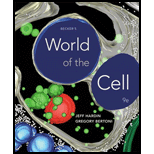
Concept explainers
The Historical Strands of Cell Biology. For each of the following events, deduce whether it belongs mainly to the cytological (C), biochemical (B), or genetic (G) strand in the historical development of cell biology.
(a) Köllicker describes “sarcosomes” (now called mitochondria) in muscle cells (1857).
(b) Hoppe–Seyler isolates the protein hemoglobin in crystalline form (1864).
(c) Haeckel postulates that the nucleus is responsible for heredity (1868).
(d) Ostwald proves that enzymes are catalysts (1893).
(e) Muller discovers that X-rays induce mutations (1927).
(f) Davson and Danielli postulate a model for the structure of cell membranes (1935).
(g) Beadle and Tatum formulate the one gene–one enzyme hypothesis (1940).
(h) Claude isolates the first mitochondrial fractions from rat liver (1940).
(i) Lipmann postulates the central importance of ATP in cellular energy transactions (1940).
(j) Avery, MacLeod, and McCarty demonstrate that bacterial transformation is attributable to DNA, not protein (1944).
(k) Palade, Porter, and Sjøstrand each develop techniques for fixing and sectioning biological tissue for electron microscopy (1952–1953).
(l) Lehninger demonstrates that oxidative phosphorylation depends for its immediate energy source on the transport of electrons in the mitochondrion (1957).
Want to see the full answer?
Check out a sample textbook solution
Chapter 1 Solutions
Becker's World of the Cell (9th Edition)
- In a small summary write down:arrow_forwardNot part of a graded assignment, from a past midtermarrow_forwardNoggin mutation: The mouse, one of the phenotypic consequences of Noggin mutationis mispatterning of the spinal cord, in the posterior region of the mouse embryo, suchthat in the hindlimb region the more ventral fates are lost, and the dorsal Pax3 domain isexpanded. (this experiment is not in the lectures).a. Hypothesis for why: What would be your hypothesis for why the ventral fatesare lost and dorsal fates expanded? Include in your answer the words notochord,BMP, SHH and either (or both of) surface ectoderm or lateral plate mesodermarrow_forward
 Human Heredity: Principles and Issues (MindTap Co...BiologyISBN:9781305251052Author:Michael CummingsPublisher:Cengage Learning
Human Heredity: Principles and Issues (MindTap Co...BiologyISBN:9781305251052Author:Michael CummingsPublisher:Cengage Learning Biology 2eBiologyISBN:9781947172517Author:Matthew Douglas, Jung Choi, Mary Ann ClarkPublisher:OpenStax
Biology 2eBiologyISBN:9781947172517Author:Matthew Douglas, Jung Choi, Mary Ann ClarkPublisher:OpenStax Anatomy & PhysiologyBiologyISBN:9781938168130Author:Kelly A. Young, James A. Wise, Peter DeSaix, Dean H. Kruse, Brandon Poe, Eddie Johnson, Jody E. Johnson, Oksana Korol, J. Gordon Betts, Mark WomblePublisher:OpenStax College
Anatomy & PhysiologyBiologyISBN:9781938168130Author:Kelly A. Young, James A. Wise, Peter DeSaix, Dean H. Kruse, Brandon Poe, Eddie Johnson, Jody E. Johnson, Oksana Korol, J. Gordon Betts, Mark WomblePublisher:OpenStax College Biology: The Dynamic Science (MindTap Course List)BiologyISBN:9781305389892Author:Peter J. Russell, Paul E. Hertz, Beverly McMillanPublisher:Cengage Learning
Biology: The Dynamic Science (MindTap Course List)BiologyISBN:9781305389892Author:Peter J. Russell, Paul E. Hertz, Beverly McMillanPublisher:Cengage Learning Concepts of BiologyBiologyISBN:9781938168116Author:Samantha Fowler, Rebecca Roush, James WisePublisher:OpenStax College
Concepts of BiologyBiologyISBN:9781938168116Author:Samantha Fowler, Rebecca Roush, James WisePublisher:OpenStax College Human Physiology: From Cells to Systems (MindTap ...BiologyISBN:9781285866932Author:Lauralee SherwoodPublisher:Cengage Learning
Human Physiology: From Cells to Systems (MindTap ...BiologyISBN:9781285866932Author:Lauralee SherwoodPublisher:Cengage Learning





